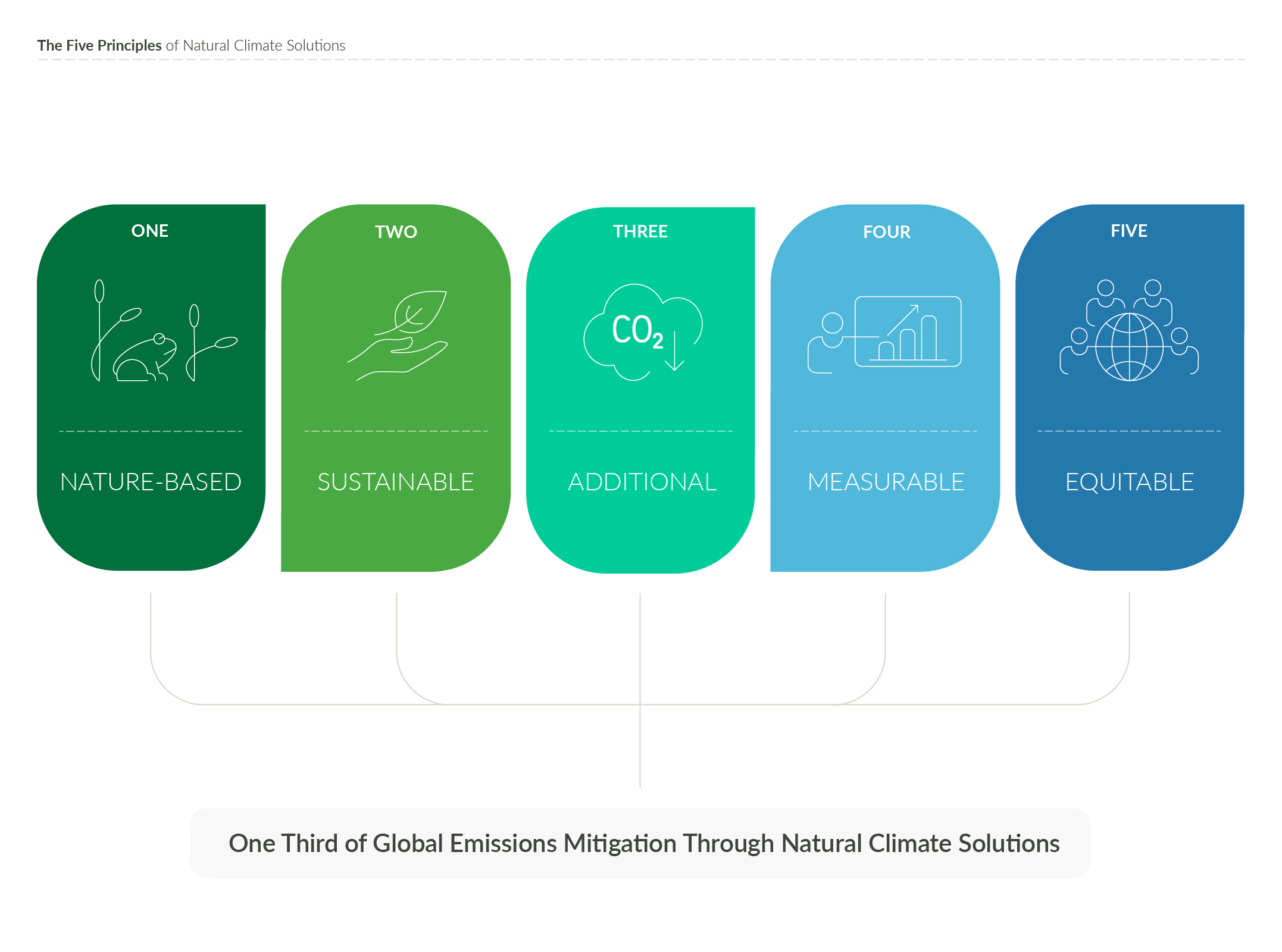New Paper Clears the Way for Action by Articulating Principles of Natural Climate Solutions
A scientific paper led by TNC outlines five principles that will help leaders define, implement and measure effective natural climate solutions.

Media Contacts
-
Adrienne Egolf
Associate Director of Communications
The Nature Conservancy
Email: aegolf@tnc.org
Resources
- Read an Executive Summary (.pdf)
- See an Infographic (.pdf)
- Download the Paper
The Nature Conservancy (TNC) has released a scientific paper outlining five key principles crucial for the global implementation of natural climate solutions (NCS). Published in the journal Nature Communications and led by TNC’s Global Director of Natural Climate Solutions Science, Peter Ellis, “The Principles of Natural Climate Solutions” provides essential guidance for activating effective, measurable, and equitable NCS, offering a powerful tool to address the urgent challenges of climate change and biodiversity loss.
The key principles outlined in the paper—nature-based, sustainable, climate-additional, measurable, and equitable—establish a comprehensive framework for identifying and implementing high-integrity NCS. This framework ensures that investments in NCS can be made confidently—yielding real-world, cost-effective, and measurable impact.
Principles of Natural Climate Solutions
Defining what constitutes real, high-integrity natural climate solutions is critical so we can implement them effectively. These principles provide practical guidance on what constitutes a natural climate solution so that investments can be made with confidence. NCS must be nature-based, sustainable, climate-additional, measurable and equitable.
Natural climate solutions are nature-based.
Principle 1.1: Natural climate solutions result from the human stewardship of ecosystems.
Principle 1.2: Natural climate solutions do not move ecosystems further from their natural state.
Natural climate solutions are sustainable.
Principle 2.1: Natural climate solutions sustain biodiversity.
Principle 2.2: Natural climate solutions sustain food production.
Principle 2.3: Natural climate solutions sustain fiber and wood production.
Principle 2.4: Natural climate solutions sustain climate adaptation services.
Natural climate solutions are additional.
Principle 3.1: Natural climate solutions provide additional climate mitigation that would not happen without intervention.
Principle 3.2: Natural climate solutions provide durable mitigation.
Principle 3.3: Natural climate solutions are not used to compensate for emissions that need to be avoided to avoid climate crisis.
Natural climate solutions are measurable.
Principle 4.1: Natural climate solutions must quantify their climate benefit as consistently and completely as possible.
Principle 4.2: Natural climate solutions accounting is conservative.
Principle 4.3: Natural climate solutions with uncertainty ranges greater than the estimated climate mitigation should be flagged as emerging.
Principle 4.4: Natural climate solutions accounting avoids double counting.
Natural climate solutions are equitable.
Principle 5.1: Natural climate solutions respect human rights.
Principle 5.2: Natural climate solutions respect Indigenous self-determination.
By adhering to these principles, practitioners can activate effective and equitable NCS, enabling the rapid adoption needed to address the climate and biodiversity crises.
“Science has shown us that we need nature in order to avoid the worst impacts of climate change,” Ellis says. “But confusion about what constitutes a natural climate solution remains a barrier to advancing these essential practices effectively. We hope this paper helps more clearly define the conversation so we can move swiftly from talking about natural climate solutions to implementing them.”
“We’ve done the research and the science is clear: To keep global temperatures in check, the land sector must reach net zero emissions by 2030—a more challenging decarbonization target compared to any other sector,” said Bronson Griscom, Vice President of Natural Climate Solutions at Conservation International and lead author of the 2017 study that found nature can provide at least 30% of the emission reductions needed to reach global climate goals. “It is imperative that we achieve two things at once: high integrity, high volume natural climate solutions, along with rapid decarbonization of all sectors.”
The paper, grounded in leading scientific research and authored by a diverse group of experts from seven organizations, provides guidelines for incentivizing and implementing global efforts to protect, better manage, and restore nature.
“In the face of a climate crisis, the world is looking for transparency and accountability in the solutions that harnesses nature’s climate mitigating potential,” said Christine Cadigan, Executive Vice President of Carbon Origination at the American Forest Foundation. “This paper provides the foundation for key principles that can guide us all toward building and scaling natural climate solutions that consistently benefit the planet and the people on it.”
Quote: Peter W. Ellis
We hope this paper helps more clearly define the conversation so we can move swiftly from talking about natural climate solutions to implementing them.
The research emphasizes the critical role NCS play in both short- and long-term climate change mitigation together with innumerous co-benefits—for people and nature alike. With the potential to deliver a third of the necessary global greenhouse gas emission reductions, NCS—which involve protecting, better managing, and restoring forests, grasslands, agricultural lands, and wetlands—offer a cost-effective and readily available means to combat climate change.
“We can’t implement NCS without people, which is why having a human rights-based approach to NCS is critical to its success,” says Vanessa Carrasco Denney, Natural Climate Solutions Science Program Manager for TNC. “We have to carefully consider the local contexts and equity implications of each project, paying special attention to respecting human rights and the self-determination of all rightsholders involved. Implementing NCS projects with high scientific and social integrity is not only the right thing to do but will also help ensure the long-term success and viability of these solutions.”
Quote: Vanessa Carrasco Denney
Implementing NCS projects with high scientific and social integrity is not only the right thing to do but will also help ensure the long-term success and viability of these solutions.
In 2017, TNC conducted a landmark study revealing the transformative potential of nature. Natural climate solutions actions, which contribute to emissions reduction and carbon storage, also support thriving ecosystems, biodiversity, and communities. The urgency of the climate crisis necessitates the swift global implementation of these solutions.
“The Principles of Natural Climate Solutions” serves as a rallying cry for global collaboration, encouraging stakeholders to not only act swiftly but to steward nature equitably, ensuring maximum climate impact. TNC remains committed to working in partnership with scientists, Indigenous Peoples, communities, and leaders worldwide to deploy nature’s potential in achieving global emissions reduction goals.
About The American Forest Foundation
The American Forest Foundation is a national conservation organization that works with a broad coalition of partners to empower family forest owners to make a meaningful conservation impact around carbon sequestration, wildfire reduction, wildlife habitat, clean water, sustainable wood supplies and support for rural communities. To learn more about the Family Forest Carbon Program, visit www.familyforestcarbon.org.
About Conservation International
Conservation International protects nature for the benefit of humanity. Through science, policy, fieldwork and finance, we spotlight and secure the most important places in nature for the climate, for biodiversity and for people. With offices in 30 countries and projects in more than 100 countries, Conservation International partners with governments, companies, civil society, Indigenous peoples and local communities to help people and nature thrive together. Go to Conservation.org for more.
The Nature Conservancy is a global conservation organization dedicated to conserving the lands and waters on which all life depends. Guided by science, we create innovative, on-the-ground solutions to our world’s toughest challenges so that nature and people can thrive together. We are tackling climate change, conserving lands, waters and oceans at an unprecedented scale, providing food and water sustainably and helping make cities more resilient. The Nature Conservancy is working to make a lasting difference around the world in 83 countries and territories (39 by direct conservation impact and 44 through partners) through a collaborative approach that engages local communities, governments, the private sector, and other partners. To learn more, visit nature.org or follow @nature_press on X.
